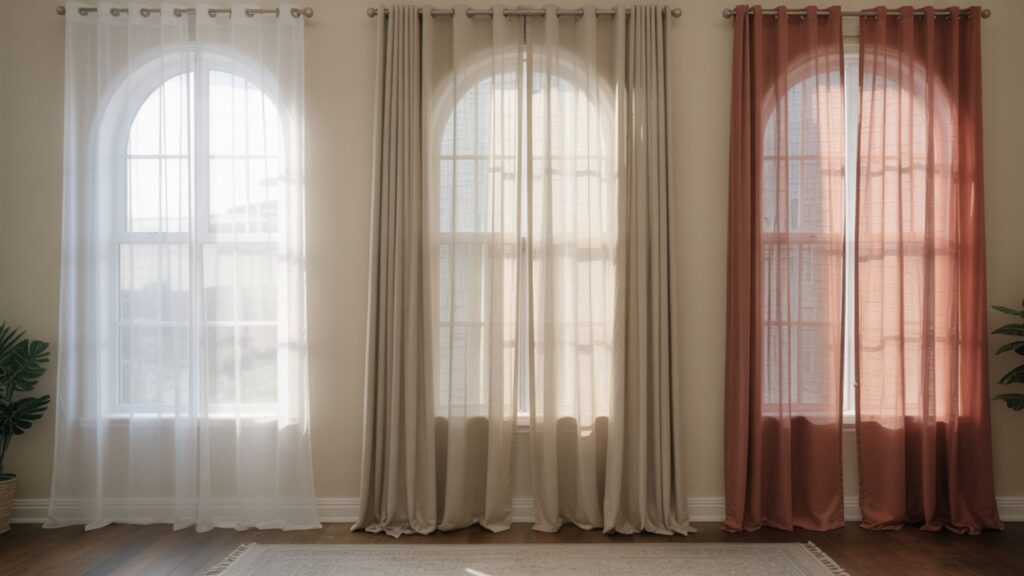I have been, or can be if you click on a link and make a purchase, compensated via a cash payment, gift, or something else of value for writing this post. As an Amazon Associate, I earn from qualifying purchases. Please read my full Affiliate Disclosure for more information.
Window treatments govern how light shapes color and mood, merging texture, opacity, and placement into a perceptual story that shifts with every hour. You feel texture sculpt light, letting smooth surfaces sharpen highlights while knotted ones scatter them softly. Sheers invite gentle glow; heavy drapes trap warmth and privacy, guiding color perception through refraction and filtering. The corridor between light and shadow becomes your mood board, transforming space as day turns to night. Keep exploring to uncover more of this nuanced interplay.
Key Takeaways
- Window treatments filter and refract light, shaping perceived color temperature, saturation, and tone in a room.
- Opacity and fabric weight control glow, shadows, and diffusion, influencing mood from bright openness to intimate coziness.
- Texture and pattern contribute depth and rhythm, guiding gaze and enhancing surface color perception.
- Layering sheers with drapes offers nuanced control of privacy, glare, and color shifts throughout the day.
- Hardware, scale, and installation affect how light, color, and mood integrate with architecture and space.
Sculpting Light: How Texturestransform Perception
Texture and light don’t just coexist; they co-design each other. You discover texture shaping perception by how light plays across surfaces, catching edges, pooling in recesses, and revealing microtopographies. Each texture invites a different light behavior: smooth weaves reflect with crisp clarity; knotted weaves scatter softly, creating gentle halos; dense felts absorb, amplifying contrast. You feel Textural contrast guiding your gaze, guiding where color deepens or loosens. Visual depth emerges as layers push forward or recede; not from color alone, but from tactile promises fulfilled by shade, highlight, and shadow. In this zone, light becomes a measured instrument of perception.

Opacity and Mood: The Dance of Sheers and Draperies
Opacity shapes mood as curtains breathe between rooms and moments. You sense how light leaks, silks and cottons picking up or softening the air, depending on opacity. Sheers invite the day inside with a whisper; draperies, a boundary that can hush or reveal. Your choices become a language: lighter fabric filters glow, heavier textures deepen shade, and every fold maps a feeling. Consider fabric patterns as subtle cues, guiding rhythm and emphasis without shouting. Installation techniques matter: placement, stacking, and hardware alter halo, movement, and perception. In quiet alignment, mood emerges—delicate, purposeful, and frankly understood.
Color Dynamics: How Window Treatments Alter Hue
Color doesn’t just tint a room; it travels through the window, shifting as light bends and refracts. You’ll see hue modulation emerge when fabric and shade interact with glass, filtering wavelengths and reshaping perception. Your choices alter color psychology by subtly elevating or dampening warmth, saturation, and contrast, not by repainting surfaces. Consider how a pale blind can cool a space or a deep drapery can warm it, without changing walls. The dynamics are deliberate, measurable, and precise: texture, translucency, and angle set the trajectory of hue, guiding mood while preserving truth in color.
Light Quality and Room Atmosphere: From Dawn to Night
As dawn creeps in and daylight shifts, the room breathes with changing light quality that turns space into mood. You sense how curtains, blinds, and fabrics filter color, shaping atmosphere from crisp morning to velvet night. Light isn’t only illumination; it’s texture, rhythm, and intention. Your choices affect privacy considerations, balancing openness with discreet moments as shadows lengthen. Window treatments modulate glare, diffusion, and contrast, guiding energy efficiency by reducing heat gain or loss across the day. In this continuum, mood deepens through subtle shifts in brightness, tone, and perception, inviting mindful alignment of function, comfort, and nuance.
Practical Styling: Tailoring Treatments to Space and Emotion
When you tailor window treatments to a space, you’re choreographing mood as much as function, choosing fabrics, heights, and hardware that whisper or shout depending on how you want the room to feel. You’ll blend patterns and motifs with material selection to articulate intention, not just cover windows. Consider how scale and texture cohere with light. Let three precise steps guide you:
- Align patterns to architectural lines, echoing or contrasting.
- Select materials for weight, drape, and acoustic comfort.
- Calibrate hardware to reflect mood—sleek for modern, ornate for intimate spaces.
Your choices shape perception, atmosphere, and emotion.
Conclusion
You’ll feel the room breathe as fabric nudges light into shape, turning corners into quiet statements. In every fold, texture edits mood; in every sliver, opacity scripts intention. Color shifts with the sun, and the air between drapery and pane sighs with possibility. This is where restraint becomes drama, and warmth becomes clarity. You’re not just dressing windows—you’re sculpting perception, translating space into mood, hour by hour, moment by moment, until the room speaks your chosen feeling.

Leave a Reply